French Riviera, Western Mediterranean
The French Riviera, the Cote d’Azur. Which ever name you call this region, the images conjured up are sure to include beautiful women, handsome men, glitzy casinos, ancient villages, fast cars and beautiful yachts lining the quays.
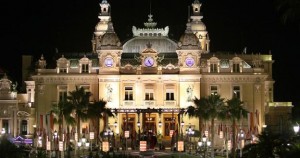
Monaco was originally founded as a Greek trading post in about 500BC. One can only imagine the looks on their faces if they were transported into the future, standing quayside as the Grand Prix cars zip past! The Principality of Monaco is based on a treaty signed with France on Feb. 2,1861. The whole economy of Monaco as we know it today was based on a small casino originally started in 1856 by the Prince, who was short of funds. In 1862, it moved to its current location, and rose to glory under the direction of Francois Blanc, with the current casino built in 1878. As the casino gained popularity, the surrounding hills became covered with luxurious houses, and as they say, the rest is history. Even if you do not want to gamble, a visit to the casino is well worth it. The magnificent gaming halls’ walls and ceilings are decorated with carvings and paintings. The atmosphere is hushed, but seems charged with suspense as the croupiers announce “Faites vos jeux”…”lay your bets”.
High on the hill on the opposite side of the harbor from the casino is the royal palace. Every day at 11:55AM sharp, the royal guards parade onto the palace’s front square, some with swords drawn, other shouldering rifles with bayonets. As the drums beat and the trumpets blare, they change guards and march off just at the palace clock strikes noon. The sight is well worth the short walk up the hill. Remember, the whole Principality is only about 486 acres, which is smaller than New York’s Central Park, so it is easy to get around on foot.
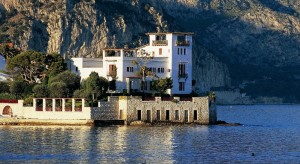 A short jaunt down the coast, brings you Saint Jean Cap Ferrat, a small peninsula between Monaco and Nice. Once there, one of the best ways to see and appreciate its beauty is on foot by wandering along the coastal path, which is divided into three parts. The entire length is only about 6 miles long, a nice walk, and even nicer if you get a ride back! The three parts include a tour of Cap Ferrat, a stroll through a lovely pine forest and the Maurice Rouvier walk which links Saint Jean Cap Ferrat to Beaulieu. One of the highlights of Beaulieu is the Greek villa “Kerylos”. This extravagant reproduction of a luxurious Greek villa is filled with mosaics, frescos and other treasures from the 6th to 10th Century BC. Topping it off are the superb gardens and incredible view of the sea – definitely a “must do”!
A short jaunt down the coast, brings you Saint Jean Cap Ferrat, a small peninsula between Monaco and Nice. Once there, one of the best ways to see and appreciate its beauty is on foot by wandering along the coastal path, which is divided into three parts. The entire length is only about 6 miles long, a nice walk, and even nicer if you get a ride back! The three parts include a tour of Cap Ferrat, a stroll through a lovely pine forest and the Maurice Rouvier walk which links Saint Jean Cap Ferrat to Beaulieu. One of the highlights of Beaulieu is the Greek villa “Kerylos”. This extravagant reproduction of a luxurious Greek villa is filled with mosaics, frescos and other treasures from the 6th to 10th Century BC. Topping it off are the superb gardens and incredible view of the sea – definitely a “must do”!
Closer to Nice is Villefranche, with its port, old town and gentle curve of coastline. The old village has narrow streets and stairways with covered passages leading down to carefully restored houses with colorful facades. The old village seems to be guarded by the Saint Elme citadel, dating back to the 16th Century.
Nice is ancient. The Greeks established it in the 5th Century as part of a string of trading posts, and named it Nikaia. However, it was probably the Romans who started it as the tourist destination that it is today with their extensive baths on Cimiez. Cimiez sits on a hill a couple of kilometers from the center of town. The grounds include a large park filled with olive groves (olive trees were introduced by the Greeks), the Archeological Museum, Matisse Museum, Franciscan Museum and the Monastery. In August the Nice Jazz Festival takes place here upon three stages, set amidst the olive groves and the Roman Amphitheater.
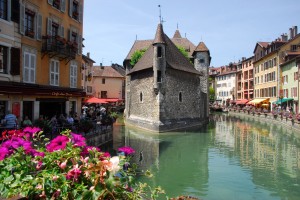
The “Vieille Ville” (Old Town) section of Nice is filled with narrow streets curving in irregular fashion between buildings topped with red-tiled roofs. The Cours Saleya has a daily flower market and food market in the mornings. The length of the Cours Saleya is lined with low buildings separating the “Cours” from the seaside. These were once used by fishermen to hold their catch, but now are mostly seafood restaurants, serving the very freshest of fish. This area might just be the most perfect spot in all of the French Riviera to linger at an outdoor café with a lovely glass of wine, golden sun warm on your face, letting the scent of the nearby ocean and the smell of the myriad of flowers wash over you. Quintessential Cote d’Azur!
Antibes was originally named “Antipolis” by the Greeks, when they founded it in the 5th Century, BC. Annexed by Rome in 43 BC, the town is full or Roman artifacts (walls, aquaducts, amphora, etc.) from the ancient town and nearby sea bottom. In 476, when the Roman Empire fell, the barbarians invaded the region. Vandals, Visigoths, Burgundians, Ostrogoths and Franks all had their turn, with the central theme being destruction. The end of the 14th Century began the start of French occupation, as the kings of France realized the key military role that Antibes could play with its location on the Franco-Savoyard frontier. There are several museums to poke about in, including the Musee Picasso (originally the Chateau Grimaldi), Musee Archeologique, and just for fun, the Musee de la Tour des Arts et Traditions Populaires (Museum of Folk Arts and Tradition). Now, all this museum hopping is sure to make you thirsty, so you might want to go visit the Hop Store Irish Pub, located near one of the marinas. Once used for storing salt, the impressive vaulted cellars have been converted in an Irish pub that is a popular meeting place for the English-speaking community.
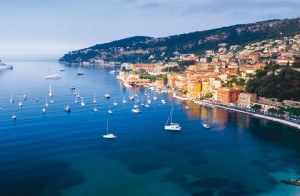
Cannes is the “star” of the French Riviera, famous for the International Film Festival and its glitzy hotels, cars and sandy beaches. The city of Cannes is centered around the old port and is very compact. Le Suquet is the old section of town, overlooking the west end of the port. The ramparts date back to the 12thCentury and give a medieval flavor to the city, as do the narrow, winding streets. The city was probably the site of a small Ligurian port and later a Roman outpost situated on Le Suquet hill, as Gallo-Roman and Roman tombs have been discovered there.
The large harbor is a comfortable anchorage, and the yachts anchoring here find both protection from the wind and waves, not to mention admiring looks from the people strolling along the Blvd. De la Croisette. In the morning the Allees de la Liberte houses a flower market, plus a popular flea market on Saturdays.
Most of the ancient activity in the area, especially for protection of the settlements, was on the Iles de Lerins, a small archipelago, just off the coast. The two main islands are Sainte-Marguerite and Sainte Honorat and the two smaller islands are Tradeliere and Sainte Fereol.

Ile Sainte-Marguerite is the larger, closer island. Covered by forests of Allepo pine and eucalyptus, it has wide paths that criss-cross it. All of the islands are pedestrian-only, with no motor vehicles allowed. Like all of the area, the islands came under various rules as different tribes and nations invaded them and drove off the former inhabitants. Though built by an earlier group, the Fort Royal was fortified by the Spanish in 1635, and they were subsequently chased out in 1637. Fort Royal is of note as it was used as a prison in the 17th Century and the Man in the Iron Mask was incarcerated there. The Fort still stands and you can visit the small cell where he was kept.
Ile Sainte-Honorat is smaller, however the walks are still quite nice and there is a Cisterian abbey there to visit. The passage between the two islands is narrow and protected. Called the “Plateau du Mileu”, it is a very popular anchorage.
Legend has it that the name of Saint-Tropez came from Torpes, a martyr who refused to abjure his faith. He was beheaded and his body placed in a boat and sent adrift. The boat was last seen drifting in the Bay, heading towards shore. Regardless of the dubious beginnings of its name, Saint Tropez was the hot spot of the Cote d’Azur during the 1950s and into the 60s, with its glittering jet-set crowds. Still very popular with tourists, it is quieter now that the crowds have moved on. Situated on the lovely blue waters of the Bay of St. Tropez, the quay is lined with terrace cafes, perfect places to linger as the clientele admire the yachts docked there. Behind the cafes, the small streets and old buildings are picturesque, but more popular for the shopping than for the historical value!
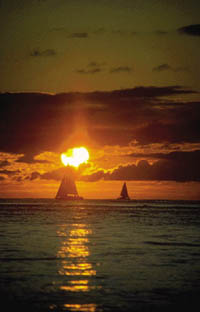
For a change of pace, a visit to a local vineyard might be in order, as there are several close by, including Domaine du Bourrian, Les Celliers des Vignerons and Domaine de Pin Pinon.
A bit south of St. Tropez, located just east of Toulon, are the three Hyeres Islands of Porquerolles Island, Port-Cross Island and Levant Island. They are also referred to as the Iles d’Or, or the “Golden Islands”, the name given to them during the Renaissance for the way the light reflected off the golden-brown mica shale.
Porquerolles is a mostly uninhabited island of Mediterranean forests, rocky coastlines, nature preserves, beaches and one small village. The major part of the island was acquired by the state in 1979 to protect the natural heritage and is known as the Conservatoire Botanique National Mediterraneen. Because of this, it is also an island of “nos”…no camping, no smoking (outside the village limits) and no drinking water (it is only available in the village). On the very positive side, Porquerolles Island is a great place for walking and cycling. In addition to the natural pines and pin parasol, myrtle, heather and fields of white cistes, there is even a vineyard.
Port-Cros was called “Mese”, or Middle Island by the Greeks. Higher and wider than Porquerolles, Port-Cros gets its name from the deep, hollowed-out shape (creux) of its small harbor. The entire area is thickly forested and is designated a Parc National, together with Ile de Bagaud and the neighboring islets, Rascas and La Gabiniere and and area extend around the coastline.
Levant Island consists of a long, narrow rocky ridge, rimmed by prodigious vertical cliffs inaccessible except for the two ports, Avis Inlet to the North and Aiguade on the western end. When the Lerins monks inhabited the islands, the Ile du Levant was the abbey’s garden and granary. Unlike the other two larger islands, it is not a National Park, nor a Botanical Conservatory, however, 80% of the island is occupied by the Marine Nationale, and access is forbidden!
The French Riviera. The Cote d’Azur. Known for its beautiful women, handsome men, glitzy casinos, ancient villages, fast cars and beautiful yachts lining the quays. But now you know there is all that, but so much more. Plenty of glitter and nightlife if that is what you desire, but plenty of beautiful gardens and quiet, private places to enjoy. Centuries of history and the very latest in fashions. The sparkle of the water as it laps against the side of your yacht, the smell of fresh baguettes, the whisper of the breeze as it brushes through the pines. Whatever it is that you seek, you will find it here. Again and again.
 ITINERARY
ITINERARY
Arriving at Nice Int’l Airport, you will be met by the crew and whisked away to the picturesque fishing port of Villefranche. Descending the winding road into the little village, you see M/Y Lady Sheridan anchored in one of the most enclosed natural bays of the Riviera.
After dinner, you will depart for quaint Portofino (90 NM, 8 hours). The next morning you will awaken to the smell of a French breakfast with freshly baked croissants. Spend the day exploring this quaint village and it’s extraordinary shops. Back on board for cocktails and a sumptuous dinner. Depart after dinner for Monaco (85 NM miles, 8 hours).
Wake up in the tiny principality of Monaco. Spend the day exploring the famous city of Monte Carlo, returning for dinner on board. After dinner, perhaps you will want to enjoy an evening at the opera or perhaps at the Casino. The next morning, depart Monaco for Cannes (25 NM, 2 hours) Spend the day exploring the city famous for its Film Festival and exclusive shopping, followed by a trip to Iles de Lerins, two small islands located a few kilometers offshore. Depart in the late afternoon for St. Tropez (25 NM, 2 hours). Enjoy cocktails while taking in the beautiful coastline. Arrive in St. Tropez for hors d’ouvers and a relaxing stroll along the marina. After dinner, enjoy the glitzy night life at the many waterfront bars and night clubs. The next day, explore the shops and art galleries or spend the day anchored off Pampelonne Beach. For the energetic, M/Y Lady Sheridan has a full complement of water toys to play on. After a fun filled day of activities, relax in the Jacuzzi, sipping cocktails and watching the sun go down on your final evening.
Early morning departure to Villefranche (40 NM, 4 hours) will have you back in plenty of time for a leisurely trip to the Nice Int’l Airport. Itinerary for private yachts courtesy of Capt. Keith Moore, M/Y Lady Sheridan
Contact Us Today
Call or text now: +1 954-632-3555
Email: info@allyachtsworldwide.com

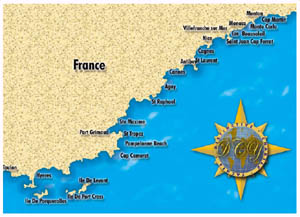 ITINERARY
ITINERARY